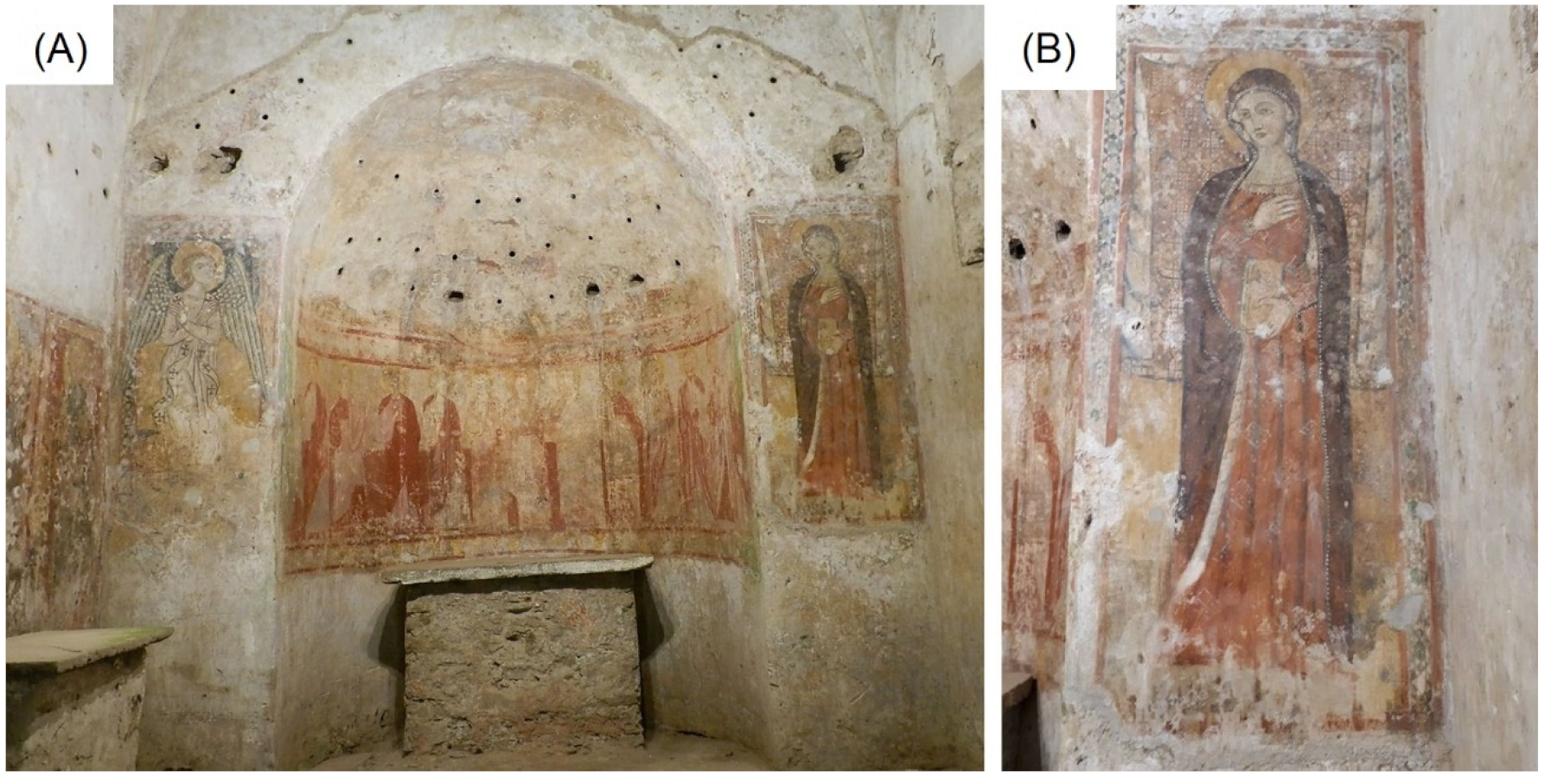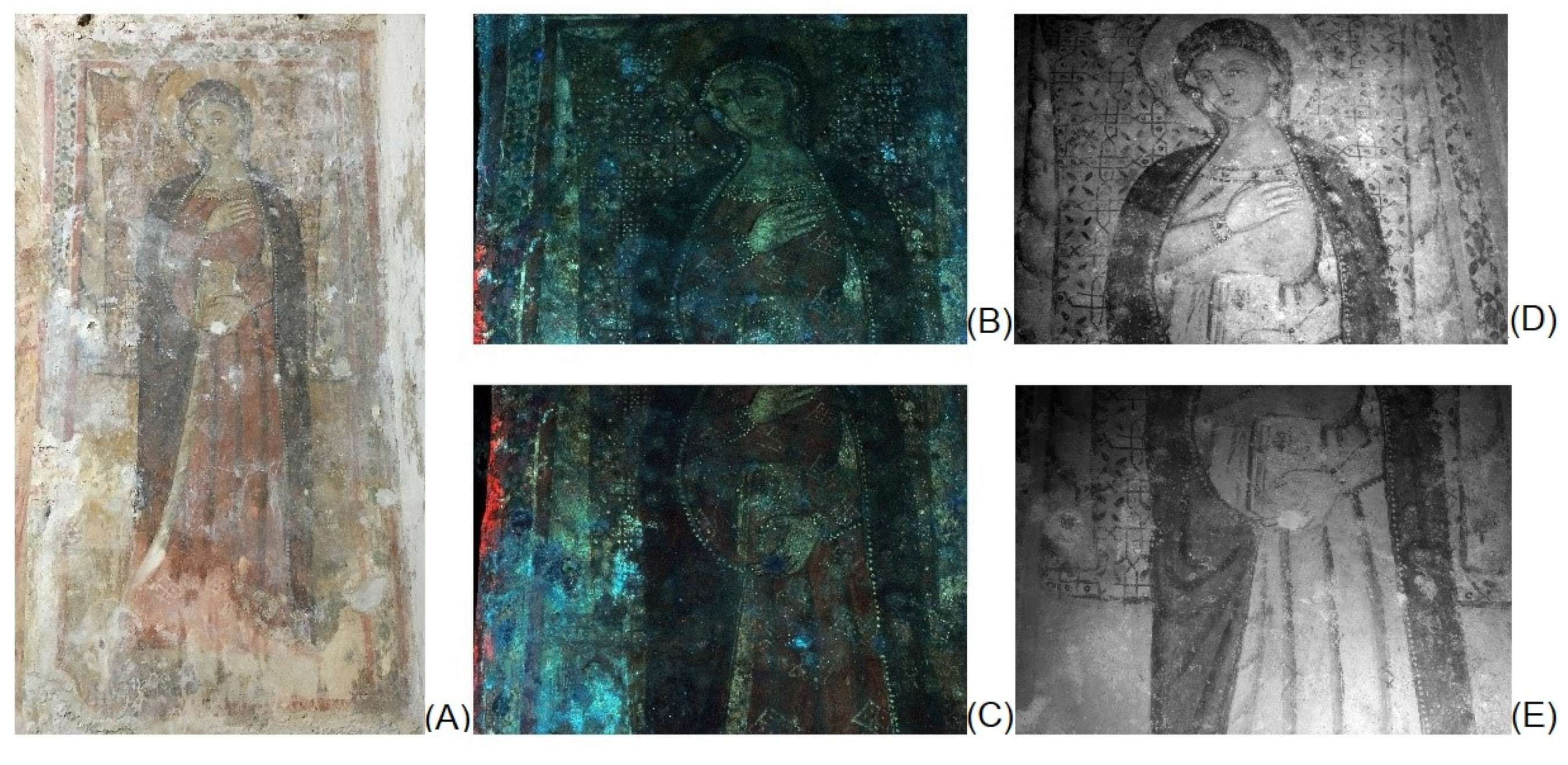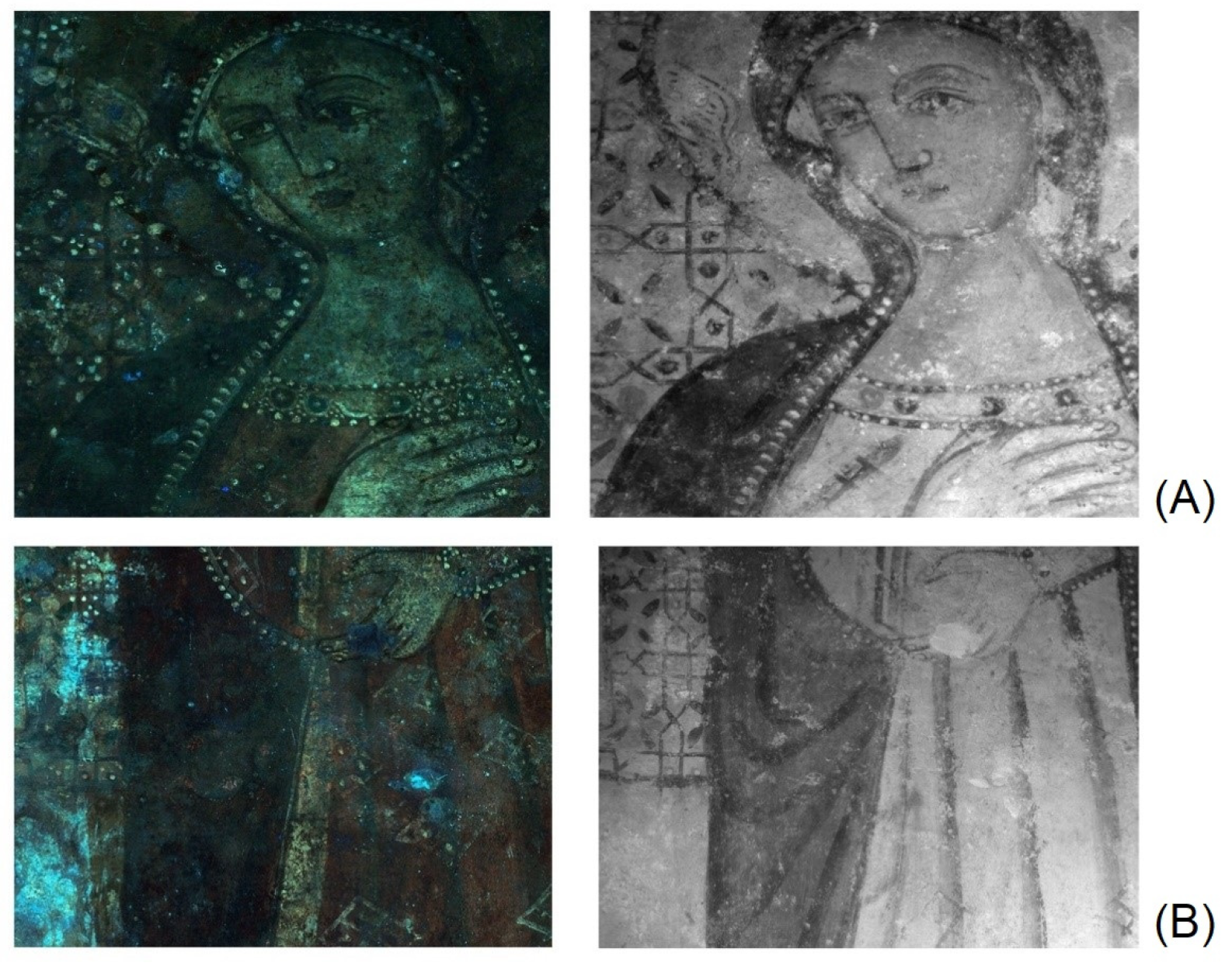Preliminary Study of the Mural Paintings of Sotterra Church in Paola (Cosenza, Italy)
Abstract
:1. Introduction and Historical Background
2. Analytical Methods
2.1. In Situ Methods
2.2. Laboratory-Based Methods
3. Results
3.1. In Situ Methods
3.2. Laboratory-Based Methods
4. Discussion
5. Conclusions
Author Contributions
Funding
Conflicts of Interest
References
- Russo, F. La Chiesa Bizantina di Sotterra a Paola: Storia ed Arte, 2nd ed.; Quaderni di Calabria Nobilissima: Cosenza, Italy, 1949; pp. 1–27. [Google Scholar]
- Musolino, G. Santi Eremiti Italogreci: Grotte e Chiese Rupestri in Calabria; Rubbettino: Soveria Mannelli, Italy, 2002; pp. 1–172. [Google Scholar]
- Verduci, R. La Chiesa Ipogea di Sotterra di Paola: La Laura di Sant’Angelo e Il Movimento Italogreco in Calabria; Laruffa: Reggio Calabria, Italy, 1991; p. 84. [Google Scholar]
- Galli, E. Attività Della R. Soprintendenza Bruzio-Lucana Nel Suo Primo Anno Di Vita: 1925; Società Magna Grecia: Rome, Italy, 1926; pp. 126–142. [Google Scholar]
- Sangineto, A.B. Un Decennio di Ricerche Archeologiche nel Territorio di Paola: Le Calabrie Romane fra II a.C. e VI d.C. In Prima e Dopo San Francesco di Paola: Continuità e Discontinuità; Clausi, B., Piatti, P., Sangineto, A.B., Eds.; Abrao: Caraffa di Catanzaro, Italy, 2012; pp. 60–62. ISBN 88-8324-153-3. [Google Scholar]
- Weyer, A.; Picazo, P.R.; Pop, D.; Cassar, J.; Özköse, A.; Vallet, J.M.; Srša, I. Ewa Glos-European Illustrated Glossary of Conservation Terms for Wall Paintings and Architectural Surfaces; The Hornemann Institute: Hildesheim, Germany, 2015; p. 19. [Google Scholar]
- Murat, Z. Wall Paintings through the Ages: The Medieval Period (Italy, Twelfth to Fifteenth Century). Archaeol. Anthropol. Sci. 2021, 13, 191. [Google Scholar] [CrossRef]
- Palazzo, E. Art and Liturgy in the Middle Ages: Survey of Research (1980–2003) and Some Reflections on Method. J. Engl. Ger. Philol. 2006, 105, 170–184. [Google Scholar]
- Escorteganha, M.R.; Bayon, J.; Santiago, A.G.; Richter, F.A.; Costa, T.G. Interdisciplinary Studies of the “Vista Do Desterro” Painting: Historical Approach, Analysis of Materials and Preservation/Restoration Techniques. Int. J. Conserv. Sci. 2015, 6, 273–286. [Google Scholar]
- Mora, P.; Mora, L.; Philippot, P. Conservation of Wall Painting; Butterworths: London, UK; Boston, MA, USA, 1984; pp. 60–61. [Google Scholar]
- Crupi, V.; Fazio, B.; Fiocco, G.; Galli, G.; La Russa, M.F.; Licchelli, M.; Majolino, D.; Malagodi, M.; Ricca, M.; Ruffolo, S.A.; et al. Multi-analytical study of Roman frescoes from Villa dei Quintili (Rome, Italy). J. Archaeol. Sci. Rep. 2018, 21, 422–432. [Google Scholar] [CrossRef]
- Bracci, S.; Iannaccone, R.; Magrini, D. The Application of Multi-Band Imaging Integrated with Non-Invasive Spot Analyses for the Examination of Archaeological Atone Artefacts. In UV-Vis LUMINESCENCE Imaging Techniques. 360 Conservation; Picollo, M., Stols-Witlox, M., Fuster-López, L., Eds.; Universitat Politècnica de València: Valencia, Spain, 2019; p. 151. [Google Scholar]
- Luciani, G.; Pelosi, C.; Agresti, G.; Lo Monaco, A. How to reveal the invisible. The fundamental role of diagnostics for religious painting investigation. Eur. J. Sci. Theol. 2019, 15, 209–220. [Google Scholar]
- Daffara, C.; Fontana, R. Multispectral Infrared Reflectography to Differentiate Features in Paintings. Microsc. Microanal. 2011, 17, 691–695. [Google Scholar] [CrossRef]
- Liang, H.; Saunders, D.; Cupitt, J. A New Multispectral Imaging System for Examining Paintings. J. Imaging Sci. Technol. 2005, 49, 551–562. [Google Scholar]
- Shackley, M.S. (Ed.) X-ray Fluorescence Spectrometry in Twenty-First Century Archaeology. In X-ray Fluorescence Spectrometry (XRF) in Geoarchaeology; Springer: New York, NY, USA, 2011. [Google Scholar]
- Edwards, H.G.M.; Vandenabeele, P. (Eds.) Analytical Archaeometry Selected Topics; The Royal Society of Chemistry: London, UK, 2012; pp. 368, 377, 387. [Google Scholar]
- Fanta Gebremariam, K.; Kvittingen, L.; Banica, F.G. Application of a portable XRF analyzer to investigate the medieval wall paintings of Yemrehanna Krestos Church, Ethiopia. Xray Spectrom. 2013, 42, 462–469. [Google Scholar] [CrossRef]
- Artioli, G. Scientific Methods and Cultural Heritage—An Introduction to the Application of Materials Science to Archaeometry and Conservation Science; Università degli Studi di Padova: Padova, Italy; Oxford University Press: Oxford, UK, 2010; p. 119. [Google Scholar]
- Schreiner, M.; Melcher, M.; Uhlir, K. Scanning electron microscopy and energy dispersive analysis: Applications in the field of cultural heritage. Anal. Bioanal. Chem. 2007, 387, 737–747. [Google Scholar] [CrossRef]
- D’Amico, S.; Comite, V.; Paladini, G.; Ricca, M.; Colica, E.; Galone, L.; Guido, S.; Mantella, G.; Crupi, V.; Majolino, D.; et al. Multitechnique diagnostic analysis and 3D surveying prior to the restoration of St. Michael defeating Evil painting by Mattia Preti. Environ. Sci. Pollut. Res. 2022, 29, 29478–29497. [Google Scholar] [CrossRef]
- Eastaugh, N.; Walsh, V.; Chaplin, T.; Siddall, R. The Pigment Compendium A Dictionary of Historical Pigments; Routledge: Oxfordshire, UK, 2004; p. 65. ISBN -0-7506-57499. [Google Scholar]
- Hradil, D.; Grygar, T.; Hradilová, J.; Bezdička, P. Clay and iron oxide pigments in the history of painting. Appl. Clay Sci. 2003, 22, 223–236. [Google Scholar] [CrossRef]
- Castagnotto, E.; Locardi, F.; Slimani, S.; Peddis, D.; Gaggero, L.; Ferretti, M. Characterization of the Caput Mortuum purple hematite pigment and synthesis of a modern analogue. Dyes Pigments 2021, 185, 108881. [Google Scholar] [CrossRef]
- Feller, R.L. (Ed.) Artists’ Pigments: A Handbook of Their History and Characteristics; Cambridge University Press: Cambridge, UK, 1986; Volume 1, p. 141. ISBN 978-1-904982-74-6. [Google Scholar]
- Comite, V.; Ricca, M. Diagnostic investigation for the study of the fresco “Madonna con il bambino”, from Cosenza, southern Italy: A case study. Soc. Geol. Italy 2016, 38, 21–24. [Google Scholar] [CrossRef]
- Larsen, R.; Coluzzi, N.; Cosentino, A. Free XRF Spectroscopy Database of Pigments Checker. Int. J. Conserv. Sci. 2016, 7, 659–668. [Google Scholar]
- Available online: http://chsopensource.org/tools-2/pigments-checker/ (accessed on 20 August 2016).
- Hochleitner, B.; Desnica, V.; Mantler, M.; Schreiner, M. Historical pigments: A collection analyzed with X-ray diffraction analysis and X-ray fluorescence analysis in order to create a database. Spectrochim. Acta Part B Atomic Spectrosc. 2003, 58, 641–649. [Google Scholar] [CrossRef]
- Hradil, D.; Hradilová, J.; Bezdicka, P. Clay Minerals in European Painting of the Mediaeval and Baroque Periods. Minerals 2020, 10, 255. [Google Scholar] [CrossRef] [Green Version]
- Hradil, D.; Hradilová, J.; Bezdička, P. New criteria for classification of and differentiation between clay and iron oxide pigments of various origins. In Acta Artis Academica 2010, Proceedings of the 3rd Interdisciplinary ALMA Conference, Prague, Czech Republic, 24–26 November 2010; Hradil, D., Hradilová, J., Eds.; Academy of Fine Arts in Prague: Prague, Czech Republic, 2010; pp. 107–136. [Google Scholar]
- Aliatis, I.; Bersani, D.; Campani, E.; Casoli, A.; Lottici, P.P.; Mantovan, S.; Marino, I.G.; Ospitali, F. Green pigments of the Pompeian artists’ palette. Spectrochim. Acta Part A Mol. Biomol. Spectrosc. 2009, 73, 532–538. [Google Scholar] [CrossRef]
- Matthew, A.J.; Woods, A.J.; Oliver, C. Spots before the eyes: New comparison charts for visual percentage estimation in archaeological material. In Recent Developments in Ceramic Petrology; Middleton, A., Freestone, I., Eds.; British Museum: London, UK, 1991; pp. 211–263. [Google Scholar]
- Randazzo, L.; Collina, M.; Ricca, M.; Barbieri, L.; Bruno, F.; Arcudi, A.; La Russa, M.F. Damage indices and photogrammetry for decay assessment of stone-built cultural heritage: The case study of the San Domenico church main entrance portal (South Calabria, Italy). Sustainability 2020, 12, 5198. [Google Scholar] [CrossRef]
- Frasca, F.; Verticchio, E.; Caratelli, A.; Bertolin, C.; Camuffo, D.; Siani, A.M. A Comprehensive Study of the Microclimate-Induced Conservation Risks in Hypogeal Sites: The Mithraeum of the Baths of Caracalla (Rome). Sensors 2020, 20, 3310. [Google Scholar] [CrossRef]
- Caneva, G.; Langone, S.; Bartoli, F.; Cecchini, A.; Meneghini, C. Vegetation Cover and Tumuli’s Shape as Affecting Factors of Microclimate and Biodeterioration Risk for the Conservation of Etruscan Tombs (Tarquinia, Italy). Sustainability 2021, 13, 3393. [Google Scholar] [CrossRef]
- Marilyn Aronberg, L. The Place of Narrative: Mural Decoration in Italian Churches, 431-1600; University of Chicago Press: Chicago, IL, USA, 1991; p. 426. [Google Scholar]
- Di Resta, J. Italian Thirteenth and Fourteenth Century Paintings, National Gallery of Ar. Available online: https://purl.org/nga/collection/catalogue/italian-paintings-of-the-thirteenth-and-fourteenth-centuries/2016-03-21 (accessed on 21 March 2016).
- Vasco, G.; Serra, A.; Manno, D.; Buccolieri, G.; Calcagnile, L.; Buccolieri, A. Investigations of byzantine wall paintings in the abbey of Santa Maria di Cerrate (Italy) in view of their restoration. Spectrochim. Acta A Mol. Biomol. Spectrosc. 2020, 239, 1386–1425. [Google Scholar] [CrossRef]
- Cheilakou, E.; Troullinos, M.; Koui, M. Identification of pigments on Byzantine wall paintings from Crete (14th century AD) using non-invasive Fiber Optics Diffuse Reflectance Spectroscopy (FORS). J. Archaeol. Sci. 2014, 41, 541–555. [Google Scholar] [CrossRef]
- Mastrotheodoros, G.P.; Beltsios, K.G. Pigments—Iron-based red, yellow, and brown ochres. Archaeol. Anthropol. Sci. 2022, 14, 35. [Google Scholar] [CrossRef]







| Area ID | Measurement Area | Color | Employed Techniques |
|---|---|---|---|
| A1 | Mantle of Virgin | Dark Red layer | p-XRF |
| A2 | Mantle of Virgin | Light Red layer | p-XRF |
| A3 | Background | Yellow layer | p-XRF |
| A4 | Detail of geometric decoration of the frame | Green layer | p-XRF |
| Sample ID | Sampling Area | Color | Employed Techniques |
| NST-2 | From the bracelet of Virgin | Green | SEM-EDS |
| NST-3 | From the book that is in the Virgin’s hand | Yellow | PLOM, SEM-EDS |
| NST-4 | From the bottom part of the Virgin’s mantle | Reddish/whitish | PLOM, SEM-EDS |
| NST-5 | From the left border of the mural painting | Reddish/whitish | PLOM, SEM-EDS |
| NST-6 | From the left part of the Virgin’s mantle | Blackish | SEM-EDS |
| Area | Type | Chemical Elements by XRF | Identified Pigment |
|---|---|---|---|
| A1 | Dark red layer | Ca, Fe, S, Si, Al (Ti, Cu, Pb, Sr) | Red Earth |
| A2 | Light red layer | Ca, Fe, S, Si, Al (Ti, Mn, Cu, Pb, Sr) | Red Earth |
| A3 | Yellow layer | Ca, S, Fe, Si, K, Al (Ti, Mn, Ni, Sr) | Yellow Earth |
| A4 | Green layer | Ca, Fe, S, K, Si, Al (Ti, Mn, Pb, Sr) | Green Earth |
| Samples ID | Layers | Type | Chemical Elements by EDS on Thin Sections |
|---|---|---|---|
| NST-3 | Layer (a) * | Layer with yellow pigment | / |
| Layer (b) | plaster | Ca, Si, Mg, Al, Fe (K) | |
| NST-4 | Layer (a) | plaster | Ca, Si, Mg, Al, Fe (Sr, S, Na, K, Pb, Cl) |
| Layer (b) | Layer with red pigment | Ca, Si, Fe, Mg, Al (Sr, S, Na) | |
| Layer (c) | plaster | Ca, Mg, Si, Fe (Al, S) | |
| NST-5 | Layer (a) | plaster | Ca, Fe, Si, Al, Mg, K (Ti, Ba, S, Cl) |
| Layer (b) | Layer with red pigment | Ca, Si, Mg (Na, Al, S, Fe, Cl) | |
| Layer (c) | plaster | Ca, Mg, Si, Fe (Al, S, Na) | |
| Samples | Areas | Type | Chemical Elements by EDS on Micro-Fragments |
| NST-2 | Surface | Green micro-fragment | Ca, Si, Mg, Al, S (Na, P, Cl, K, Fe) |
| NST-3 | Surface | Yellow micro-fragment | Ca, Si, Mg, Al, Fe (K, Cl) |
| NST-6 | Surface | Blackish micro-fragment | Si, Ca, Mg, Al, S, Fe (Na, Cl, K, P) |
Publisher’s Note: MDPI stays neutral with regard to jurisdictional claims in published maps and institutional affiliations. |
© 2022 by the authors. Licensee MDPI, Basel, Switzerland. This article is an open access article distributed under the terms and conditions of the Creative Commons Attribution (CC BY) license (https://creativecommons.org/licenses/by/4.0/).
Share and Cite
Ricca, M.; Alberghina, M.F.; Houreh, N.D.; Koca, A.S.; Schiavone, S.; La Russa, M.F.; Randazzo, L.; Ruffolo, S.A. Preliminary Study of the Mural Paintings of Sotterra Church in Paola (Cosenza, Italy). Materials 2022, 15, 3411. https://doi.org/10.3390/ma15093411
Ricca M, Alberghina MF, Houreh ND, Koca AS, Schiavone S, La Russa MF, Randazzo L, Ruffolo SA. Preliminary Study of the Mural Paintings of Sotterra Church in Paola (Cosenza, Italy). Materials. 2022; 15(9):3411. https://doi.org/10.3390/ma15093411
Chicago/Turabian StyleRicca, Michela, Maria Francesca Alberghina, Negin Derakhshan Houreh, Aybuke Sultan Koca, Salvatore Schiavone, Mauro Francesco La Russa, Luciana Randazzo, and Silvestro Antonio Ruffolo. 2022. "Preliminary Study of the Mural Paintings of Sotterra Church in Paola (Cosenza, Italy)" Materials 15, no. 9: 3411. https://doi.org/10.3390/ma15093411
APA StyleRicca, M., Alberghina, M. F., Houreh, N. D., Koca, A. S., Schiavone, S., La Russa, M. F., Randazzo, L., & Ruffolo, S. A. (2022). Preliminary Study of the Mural Paintings of Sotterra Church in Paola (Cosenza, Italy). Materials, 15(9), 3411. https://doi.org/10.3390/ma15093411









